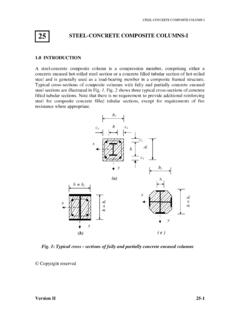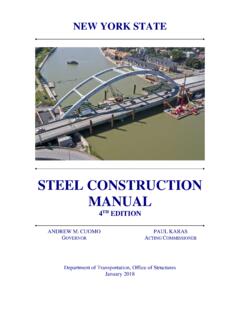Transcription of The New Categorized Approach to Architecturally ... - AISC
1 1reprinted from Modern steel CONSTRUCTION | NOVEMBER 2017 The New Categorized Approach to Architecturally Exposed Structural steel : An Overview2reprinted from Modern steel CONSTRUCTION | NOVEMBER 2017 WHEN THE WORD steel is mentioned, its flexibility, durability and strength typically come to mind. But what about its beauty? More and more designers are choosing to expose steel in their projects not just out of a sense of practicality or functionality, but also for its aesthetic attributes. They do so because they realize that steel can do more than simply support a design; it can also become an integral part of it. And in doing so, they often hold steel to as high a standard as any other fixture or finish. They aren t just going for an industrial look.
2 They re elevating the material to a new level: Architecturally exposed structural steel (AESS). So where to begin when considering AESS for your next project? Start with the 2016 AISC Code of Standard Practice (ANSI/AISC 303-16) implements a defined Approach to specifying AESS in the contract documents by using five categories AESS 1, 2, 3, 4 and C which differentiate levels of steel fabrica-tion and erection . As the numbers in this tiered system rise, the cost and time for fabrication and erection typically also increase. (A similar Approach was adopted in the Canadian Code of Standard Practice in 2009 via the Canadian Institute of steel Construction CISC Code of Standard Practice for Structural steel , Seventh Edition.)
3 Previous versions of the codes did not define the terms of AESS as distinctly, leav-ing room for interpretation and cost escalation, and this lat-est version of the AISC Code helps clear things up. The new guidelines establish the same level of expectations between designers, fabricators and erectors for the visual appearance of AESS. The category system provides architects with a method of articulating AESS in their projects with a much clearer understanding of deliverables. Exposed or Architecturally Exposed? The AISC Code defines structural steel as elements that are required to support the design loads of a building and fit within the components of a structural frame. For clar-ity, the AESS category system is typically only applied to fabricated structural steel as referenced in Section of the Code: anchor rods, base plates, beams, bracing, canopy framing, columns, connection materials, crane stops, girders, lintels, posts, shear stud connectors, trusses, etc.
4 Unfinished, reused, galvanized or weathering steel members may all be fabricated with AESS requirements. AESS goes a step beyond standard fabrication and erec-tion. During fabrication , shipment and erection , extra care is taken to avoid blemishes and unwanted surface appearance when handling the steel and removing temporary braces or fixtures. For some categories, all backing and runoff tabs are removed, and welds are to be ground smooth for those areas. Basic unpainted steel must also be cleaned of oil, grease, dirt and loose mill. There are other steel , iron or metal items that are not typically specified as AESS, though there may be exceptions depending on project requirements. Cables, castings, catwalks, chutes, cold-formed steel products, corner guards, flagpole supports, grating, handrails, ladders, ornamental metal, stacks, stairs, steel deck, open-web steel joists, joist girders and trench-es are examples of components that do not typically receive AESS identification (reference Section of the AISC Code for the full list).
5 Everyone in the building industry is familiar with the phrase location, location, location. When Architecturally exposing the structure as an integral part of the design intent, the following phrase comes into play: coordination, coordination, coordina-tion. While the architect chooses the locations of AESS in a project, the structural engineer should document it. According to Bill Andrews, SE, a principal at structural engineering firm Walter P Moore, fabricators and detailers will typically look to the structural drawings in the contract documents as the pri-mary source of information for structural steel , including AESS. This methodology saves time and cost during construction, with the intent of consolidating references to AESS as much as possible.
6 It is of utmost importance that successful coordina-tion between these disciplines takes place to ensure the contract documents are bid per the design ExposureA guide to understanding and specifying the various categories of Architecturally exposed structural steel (AESS). 3reprinted from Modern steel CONSTRUCTION | NOVEMBER 2017 Lighting typically has the greatest impact on interior AESS, whereas sight lines are the most important for AESS located on the exterior. Details are not as visible in high ceilings with low lighting, including shaded steel . However, when elements are brightly lit, they may tend to expose more texture and blemishes on the surface. The location and type of lighting with relation to AESS components should be determined prior to specifying the appropriate Dravitz PhotographyRyan Dravitz Photography4 Equally imperative is selecting the correct category for all AESS components in a project.
7 Per the AISC Code, it is re-quired that all AESS is identified as Categories 1, 2, 3, 4 or C. This is a dramatic improvement over the previous code edi-tion [2010], says Andrews, in terms of better clarity, articu-lating and giving everyone a better understand-ing of relative costs when choosing AESS and at what level. Sufficient coordination and understanding of best practices are essential to keeping a project within budget and schedule. ContextThere are many factors that influence the level of finish and detailing on an exposed member. It is important to un-derstand the context surrounding the exposed steel before choosing an AESS category. The following explains which elements impact AESS and how it is perceived in the built environment: member visibility, viewing distance, location, lighting, coatings, style and visibility.
8 Simply put, if it is not readily visible, there is no need to identify exposed steel as AESS. There are often conditions where one side of an exposed steel column or braced frame may be blocked from view by a wall or other component. It is possible to note a specific AESS category only on the side of an exposed member that is visible to view. Specifying AESS incurs more time and care during design, fabrication and erection and should only be spent on por-tions of the project that are visible and prominent. Identify-ing specific locations for AESS takes careful consideration, but thoughtful analysis can greatly reduce cost and time dur-ing distance. Details tend to disappear from the naked eye the further away they are located.
9 When an object is beyond 20 ft away, the distinction between components is not as clearly seen as when it is within reach. Consider objects 100 ft away from the closest point of view, and the level of visible detail is even less distinct. The category sys-tem for AESS recognizes that viewing distance is critical to the level of fabrication and erection required for structural steel . The 20-ft viewing distance separates categories AESS 2 and AESS 3. Location. Whether AESS is placed on the interior or exterior of a building has a significant impact on the type of coating and protection selected for the member, as well as how it is detailed. If placed on the exterior of a build-ing, the exposed steel must withstand more corrosive or harsh climate conditions.
10 Additional surface preparation and protective coatings are often implemented to promote long-lasting AESS. Detailing at joints or connections must also take special care to keep water out to avoid corrosion of steel According to Steve Weiss, principal and founder of Weiss Architects, lighting typically has the great-est impact on interior AESS, whereas sight lines are the most important for AESS located on the exterior. Details are not as visible in high ceilings with low lighting, but when ele-ments are brightly lit, they may tend to expose more tex-ture and blemishes on the surface. The location and type of lighting with relation to AESS components should be deter-mined prior to specifying the appropriate AESS requiring fire protection, one option is to apply an intumescent coating.












